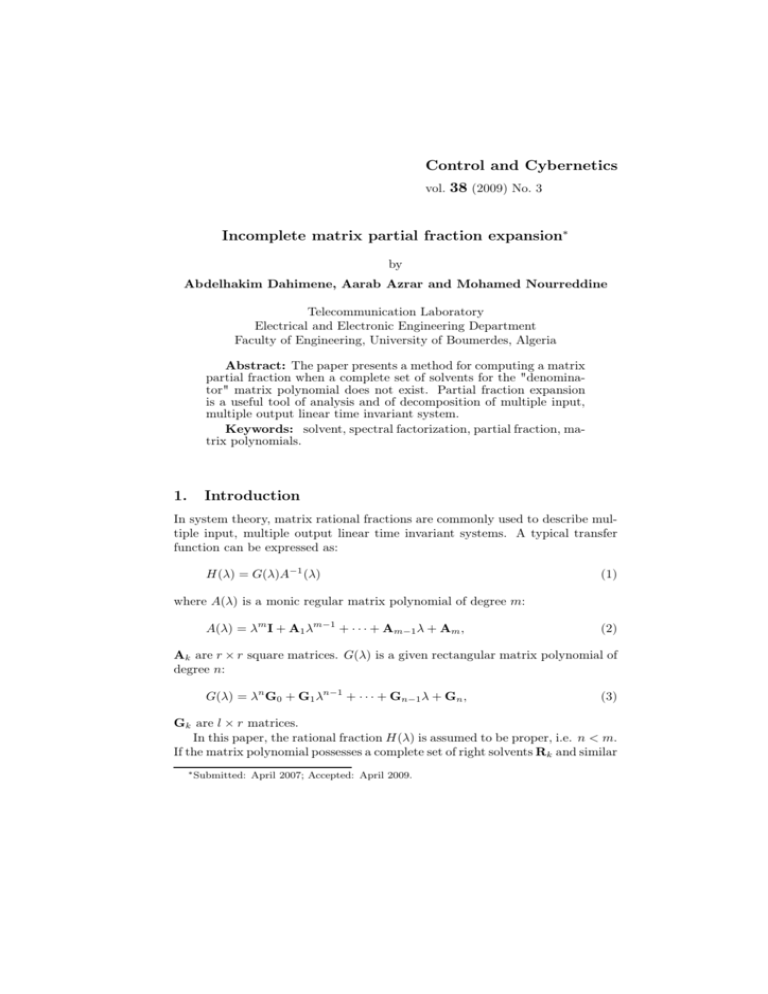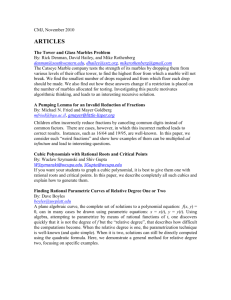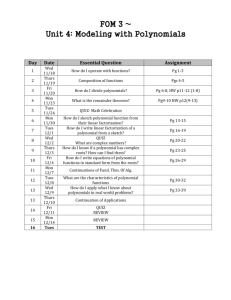Control and Cybernetics Incomplete matrix partial fraction expansion
advertisement

Control and Cybernetics vol. 38 (2009) No. 3 Incomplete matrix partial fraction expansion∗ by Abdelhakim Dahimene, Aarab Azrar and Mohamed Nourreddine Telecommunication Laboratory Electrical and Electronic Engineering Department Faculty of Engineering, University of Boumerdes, Algeria Abstract: The paper presents a method for computing a matrix partial fraction when a complete set of solvents for the "denominator" matrix polynomial does not exist. Partial fraction expansion is a useful tool of analysis and of decomposition of multiple input, multiple output linear time invariant system. Keywords: solvent, spectral factorization, partial fraction, matrix polynomials. 1. Introduction In system theory, matrix rational fractions are commonly used to describe multiple input, multiple output linear time invariant systems. A typical transfer function can be expressed as: H(λ) = G(λ)A−1 (λ) (1) where A(λ) is a monic regular matrix polynomial of degree m: A(λ) = λm I + A1 λm−1 + · · · + Am−1 λ + Am , (2) Ak are r × r square matrices. G(λ) is a given rectangular matrix polynomial of degree n: G(λ) = λn G0 + G1 λn−1 + · · · + Gn−1 λ + Gn , (3) Gk are l × r matrices. In this paper, the rational fraction H(λ) is assumed to be proper, i.e. n < m. If the matrix polynomial possesses a complete set of right solvents Rk and similar ∗ Submitted: April 2007; Accepted: April 2009. 650 A. DAHIMENE, A. AZRAR, M. NOUREDDINE left solvents Lk , the above matrix rational fraction can be expanded in partial fractions (Tsay et al., 1982): H(λ) = m X Xk (λI − Lk ) −1 (4) . k=1 The residues are given by (Dahimene, 1992): (5) −1 Xk = GR (Rk )PkR (Rk ) Pk (λ) = (λI − Lk ) −1 (6) A(λ). The subscript R indicates a right evaluation of the matrix polynomial: AR (X) = Xm + A1 Xm−1 + ... + Am−1 X + Am , X is an r × r square matrix. Partial fraction expansions are very useful in system analysis and design. We can cite in this context system order reduction using dominant poles (which are the latent roots of the "denominator"). 2. The incomplete matrix partial fraction Unfortunately, it is rare to find matrix polynomials having a complete set of solvents. A more common case is provided by the following factorization of the "denominator" A(λ). The matrix polynomial A(λ) has a right and a left spectral factor of degree k (Gohberg et al., 1982). In other words, we can write: A(λ) = Πk (λ)Fk (λ) = F k (λ)Πk (λ), (7) where Πk (λ)and Πk (λ) are degree k monic matrix polynomials, Fk (λ) and F k (λ) are degree m − k monic matrix polynomials with the following relations between spectra: σ(Πk ) = σ(Πk ) ; σ(Fk ) = σ(Fk ) σ(Πk ) ∩ σ(Fk ) = ∅ ; σ(Πk ) ∩ σ(Fk ) = ∅ (8) A special case of the above factorization is that when A(λ) has a right solvent R. It will also have a left solvent L with the same spectrum. If the matrix polynomial A(λ) satisfies the properties (7) and (8), then the rational fraction H(λ) can be expanded as: −1 H(λ) = U (λ)Π−1 k (λ) + V (λ)F k (λ), (9) where U (λ) is an l × r matrix polynomial of degree deg U < k and V (λ) is also an l × r matrix polynomial of degree deg V < m − k. The result given by equation (9) is a proper matrix rational fraction. To prove the above result, we need the following theorem. Incomplete matrix partial fraction expansion 651 Theorem 1 The linear diophantine equation X(λ)A(λ) + Y (λ)B(λ) = C(λ) (10) has always a solution X(λ) and Y (λ) if and only if the greatest common right divisor of A(λ) and B(λ) is a right divisor of C(λ). Proof. (See Kucera, 1979). An easily proved corollary follows. Corollary 1 If A(λ) and B(λ) are right coprime matrix polynomials, (10) has always a solution. The main result can now be stated as the subsequent proposition. Proposition 1 Any l × r matrix polynomial G(λ) of degree less than m can be written as: G(λ) = X(λ)Πk (λ) + Y (λ)Fk (λ) (11) where X(λ) and Y (λ) are r matrix polynomials of degree less than m − k and k respectively. Proof. (11) is a linear diophantine equation and since σ(Πk ) ∩ σ(Fk ) = ∅, then it has always a solution. The general solution is given by Kucera (1979): X(λ) = X0 (λ) − T (λ)B1 (λ) Y (λ) = Y0 (λ) + T (λ)A1 (λ) where T (λ) is an arbitrary matrix polynomial. X0 (λ) and Y0 (λ) a particular solution of (11), while A1 (λ) and B1 (λ) are coprime matrix polynomials such that: B1 (λ)Πk (λ) = A1 (λ)Fk (λ). Using the fact that A(λ) has the right and left spectral factorization (7), we have A1 (λ) = Πk (λ) and B1 (λ) = F k (λ). Dividing Y0 (λ) by Πk (λ), which yields Y0 (λ) = U (λ)Πk (λ) + V (λ); deg V < k Y (λ) = U (λ)Πk (λ) + V (λ) + T (λ)Πk (λ), T (λ) being an arbitrary polynomial, we can set it as: T (λ) = −U (λ) and then: Y (λ) = V (λ) X(λ) = X0 (λ) + U (λ)F k (λ). So: G(λ) = Y (λ)Fk (λ) + X(λ)Πk (λ) And, since deg Fk = m − k, deg Y < k and deg G < m, then deg X(λ)Πk (λ) < m − k. Finally, deg X < m − k. 652 A. DAHIMENE, A. AZRAR, M. NOUREDDINE The above proposition has the consequence that proper matrix rational fractions can be expanded in incomplete partial fractions. Let A(λ) have the factorization given by (7) and (8), and H(λ) given by (1). G(λ) being a matrix polynomial of degree less than m, we can develop it as in (11): G(λ) = X(λ)Πk (λ) + Y (λ)Fk (λ) deg X < m − k deg Y < k. So, using (1), (7) and ((11), the rational matrix H(λ) becomes: −1 H(λ) = Y (λ)Π−1 k (λ) + X(λ)F k (λ). Each term in the above sum is a proper matrix rational fraction. In order to compute the residues X(λ) and Y (λ), we can use the fact that X(λ)Πk (λ) modΠk (λ) = 0 and [Y (λ)Fk (λ)] modFk (λ) = 0 (mod is the modulo operation, i.e. the remainder of the division by its argument) to obtain the following two equations: G(λ) mod Πk (λ) = [Y (λ)Fk (λ)] mod Πk (λ) G(λ) mod Fk (λ) = X(λ)Πk (λ) mod Fk (λ). (12) (13) Equations (5) and (6) are a special case of the above relations. They apply for Πk (λ) = (λI − L) and Πk (λ) = (λI − R). Equations (12) and (13) provide us with sets of matrix equations between the coefficients of X(λ) and Y (λ) that can be easily solved. As a numerical example, consider the following matrix polynomial: −6 −3 12 11 −9 −12 +λ A(λ) = λ3 I + λ2 + . (14) −1 −6 4 13 −3 −8 This is a purely constructed example, chosen because it has simple factors (the coefficients have integer values). It has the following factorization: 3 9 Πk (λ) = λI + (15) −4 −9 −9 −12 12 20 Fk (λ) = λ2 I + λ + (16) 3 3 −5 −8 −3 −2 Πk (λ) = λI + (17) 0 −3 −3 −1 3 2 F k (λ) = λ2 I + λ + . (18) −1 −3 1 2 Consider now the following matrix rational fraction: H(λ) = G(λ)A−1 (λ) (19) 653 Incomplete matrix partial fraction expansion along with: 2 G(λ) = λ I + λ 2 3 3 5 + 5 1 3 6 (20) . We obtain the following partial fraction: −1 (21) H(λ) = Y (λ)Π−1 k (λ) + X(λ)F k (λ). By computing the coefficients of X and Y using (12) −391 −283 −5 −290 31 31 31 31 X(λ) = λ + 60 163 −76 −51 31 31 31 31 and (13), we obtain: (22) and Y (λ) = Y0 = −27 −6 −71 2 −6 . (23) In order to find a particular spectral factorization of the matrix polynomial A(λ), one can apply the right and left matrix quotient-difference (QD) algorithm as developed in Dahimene (1992). This algorithm is a generalization of the scalar one (Henrici, 1958) to matrix polynomials. 3. Conclusion In this paper, a method for decomposition of matrix rational fraction is developed. This method presents the advantage of being more general than the simple case of a complete set of solvents. It can be applied to a more general class of matrix polynomials that just have to satisfy the requirements (7) and (8). The method has been presented for a right division. The same results (with transposition) can be presented for a left division. The method allows for better system analysis and design since it enables the decomposition of complex systems into a parallel combination of simpler systems. References Dahimene, A. (1992) Algorithms for the Factorization of Matrix Polynomials. Master thesis, INELEC, Boumerdes. Gohberg, I., Lancaster, P. and Rodman, L. (1982) Matrix Polynomials. Academic Press. Henrici, P. (1958) The Quotient-Difference Algorithm. Nat. Bur. Standards Appl. Math. Series 49, 23–46. 654 A. DAHIMENE, A. AZRAR, M. NOUREDDINE Kucera, V. (1979) Discrete Linear Control: The Polynomial Equation Approach. John Wiley. Tsay, Y.T., Shieh, L.S., Yates, R.E. and Barnett, S. (1982) Block Partial Fraction Expansion of a Rational Matrix. Linear and Multilinear Algebra 11, 225-241.








